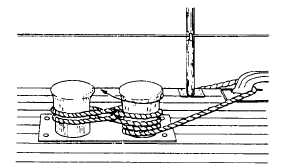| |
below before the ship gets outside in heavy weather. If
line must be stowed wet, it should be laid up on gratings
in long fakes so that it may dry as quickly as possible.
It should never be covered over.
SYNTHETIC FIBER LINES
LEARNING OBJECTIVES: Describe the
general usage and care of synthetic line. List
safety precautions for handling synthetic line.
Aramid, nylon, polyester, polypropylene, and
polyethylene, in the descending order of strength are the
synthetic fibers used to make line.
Synthetic fiber line has several advantages over
manila. Size for size, it is 1.7 to nearly 6 times as strong
and lasts 5 times as long. On a strength for strength
basis, a synthetic fiber line of less than half the size of a
manila line is required for the same task. For these
reasons, synthetic fiber is cheaper in the long run, even
if its initial price is more. Because synthetic fiber does
not rot or age as does natural fiber line, its strength is
more stable throughout its life. It is less bulky, more
flexible and, therefore, easier to handle and requires less
stowage space. Other advantages, and a few
disadvantages, are pointed out later in this discussion.
NAVSEA has also approved a new synthetic fiber,
aramid fiber line (Kevlar), for use aboard ship as
mooring and tending lines. aramid rope is lighter, easier
to handle, and smaller than nylon or polyester of
equivalent strength. It also requires less hawser reel
storage space. However, since it stretches only 6
percent at minimum breaking strength, tattle-tale cords
cannot be used to determine the strain on their line, and
the line will respond differently compared to other
synthetic lines, which stretch 30 to 65 percent at
minimum breaking strength. Also, this aramid line does
not fuse and smoke when surged around the bitts. The
line surges smoothly around bitts compared to other
synthetic mooring lines. Aramid line safety precautions
that should be observed will be discussed later.
A coil of synthetic fiber line, unlike natural fiber
line, is not opened by pulling the end up through the eye
of the coil. It should be unreeled in the same manner as
wire rope. (See the section on Wire Rope in this
chapter.) Normally, plain-laid nylon line is right-handed
and should be coiled on capstans and reels in a
clockwise direction. Cable-laid nylon or synthetic line
is left-laid and should be coiled on capstans or reels in
a counterclockwise direction.
Because of the characteristics of synthetic line,
safety precautions more explicit than those for manila
line must be observed. A complete list of precautions is
located in chapter 613 of the Naval Ships’ Technical
Manual (NSTM), but some of the more important
safety precautions to be observed are listed below:
1. Because of the lower coefficient of friction of
synthetic fiber line, exercise extreme care when a line is
being payed out or eased from securing devices (bitts,
cleats). For control in easing out, take two round turns
and no more than two figure-eight bends. Any more than
this will present danger to personnel and difficulty in
handling the line. All lines on capstans and gypsy heads
shall be payed out using power and never by surging.
Figure 3-1 shows the method of securing a mooring line
to the bitts.
2. Since a snap-back action inevitably occurs when
a line parts under tension, never allow personnel to stand
in the direct line of pull of the line when it is being pulled
or when it is under tension. A synthetic line parting under
tension will snap back at near the speed of sound, and
reaction time to clear the area will not be available.
Where possible, position line handlers 90° from the
direction of the tension force (fig. 3-2).
3. Synthetic line has higher breaking strengths than
equal sizes of manila line. Failures of blocks, pad eyes,
shackles, and line couplings can be caused by improper
substitutions. For this reason, personnel should
determine the identification and capacity of all gear and
fittings used with synthetic fiber line to ensure that their
strength exceeds the minimum breaking strength of the
line.
4. Synthetic line has poor knot-holding character-
istics. Some knots that offer good characteristics for
securing manila line, such as the square knot, are not
adequate for belaying or securing synthetic line. The
bowline is one knot known to offer reasonable security
when bending together or securing synthetic line.
Figure 3-1.–Securing lines to bitts.
3-4
|

